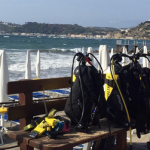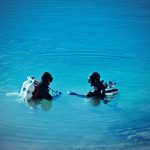
What is the recommended water temperature for a drysuit?
If you’re considering switching to using a drysuit for scuba diving. Or if you’re looking to go scuba diving in colder waters than you’re used to. You may be asking, at what temperature do you need a drysuit and what is the drysuit temperature range?
The temperature range over which you need a drysuit to scuba dive is anywhere between 14-21°C (57-70°F). The temperature at which you need a drysuit will depend on your personal tolerance to the cold.
The best way to do more diving in your drysuit is to book yourself on a scuba diving liveaboard, as there are a few places where a drysuit is better than a wetsuit to keep you warm (e.g. Mexico’s Guadalupe Island and The Galapagos Islands). You can check the latest and best deals on liveaboards using the following window:
What is the drysuit temperature range?
The temperature at which you need a drysuit to scuba dive is anywhere between 14-21°C (57-70°F). Which you might argue is quite a wide temperature range.
That may be true, but there’s a reason for it.
The need for a drysuit is dependent on your tolerance to cold water
The temperature at which you decide that a drysuit becomes necessary largely depends on your personal tolerance to the cold.
If you are a person who “feels the cold” then you may be at the top end of this temperature range when you’ll need a dry suit in colder water diving.
The higher your tolerance to the cold, the closer to the 14°C (57°F) you can wait before you need a drysuit. But having said that, scuba diving is for enjoyment and it isn’t a competition to see who can get to the coldest temperature before donning a drysuit!
I dived in a semi-dry suit for years in waters as cold as 8-9° (46-48°F) and I was still warm whilst diving. But once I discovered drysuit diving, I immediately switched to using a drysuit instead. The main reason for this is explained further below and justified the additional cost of buying the drysuit.
A drysuit is also beneficial in cold weather on your dive interval
The need for a drysuit is not only about the temperature of the water. It is also about the weather conditions above the water between dives.
If you’re on a dive boat and its wet and cold. If you add a lack of shelter on the dive boat to the cold wet conditions, you’ll be glad you wore a drysuit. This is especially true if you’re doing two dives.
If you’re diving using either a wetsuit or a semi-dry suit in cold wet weather, before the second dive you’ll be putting on a cold and wet wetsuit or semi-drysuit.
There’s nothing worse than pulling on a cold suit. I know this from first-hand experience, as I did this plenty of times diving in the Farne Islands in the UK’s North Sea.
The water temperature at the time of year I would dive there (late September/early October) would be around 9°C (48°F). Add to this cold winds, rain and a lack of shelter, I sometimes entered the water on my second dive shivering!!
It was only when I dived there for the first time in a drysuit that I realised the added benefit of how a drysuit kept me warm during the dive interval too.
On another occasion diving in the UK I ended up with the onset of hypothermia. I was diving with a group of army divers on a wreck in the entrance to Portland harbour from a squidgy inflatable boat.
The rain was like stair rods and it was freezing. I was cold and wet going to and from the dive site and on the dive itself, as I was wearing a semi-dry suit. Had I been wearing a drysuit, I’d never have got hypothermia.
More Reading: What is the difference between a drysuit and a semi dry suit?

Why is a drysuit needed in cold water?
Most divers know that water sucks heat out of your body 25 times faster than air of the same temperature.
For example, in the UK room temperature tends to be around 21°C (57°F) and feels comfortable. However, swimming in water at the same temperature, without at the very least wearing a wetsuit, would feel quite cold in contrast.
Therefore, the colder the water, the more insulation you need to protect you from heat loss.
The exposure suit you wear will keep you comfortable on your dive and prevent hypothermia. A drysuit works because it keeps you dry, which is unlike a wetsuit or semi-dry suit of course.
More Reading: What is the difference between a wetsuit and a dry suit?
Burning calories and conserving air
In addition to keeping you warm on a dive in cold waters, a drysuit will help you conserve your air too. This works on the basis that when you’re cold you will burn more calories, which is necessary required to keep warm.
If you are burning more calories or energy, you’ll require more air to fuel this process inside your body. In turn this will cause you to breath more (i.e. supply your energy burn with oxygen) and shorten how long you can dive for.
More Reading: 28 Tips on How to Conserve Air While Scuba Diving (How To Extend Your Dive Time Safely)
Drysuit temperature range is affected by what you wear under your drysuit
Earlier in this article I talked about your tolerance to the cold. The temperature at which you may decide to wear a drysuit instead of a wetsuit or semi-dry suit is also affected by what you wear under your drysuit too.
If you decide to use a drysuit where a wooly bear type insulating garment is necessary, these insulating garments come in different TOG ratings. This is just like duvets for your bed. The higher the TOG rating, the warmer the under garment.
There’s nothing to prevent you from having more than one thermal insulating garment, each with a different TOG rating. This way you can wear your drysuit in different temperature ranges and always be warm and dry.
I hope you enjoyed this article about at what temperature do you need a drysuit
I’d love to hear from you. Tell us about your adventures of diving and snorkeling, in the comments below. Please also share your photos. Either from your underwater cameras or videos from your waterproof go-pro’s!
If this article hasn’t answered all of your questions. If you have more questions either about snorkeling or scuba diving (or specifically about at what temperature do you need a drysuit), please comment below with your questions.
There will also be many more articles about scuba and scuba diving safety tips (and on snorkeling too) for you to read and learn about this fabulous sport.
Have fun and be safe!




